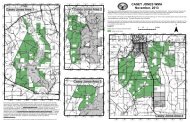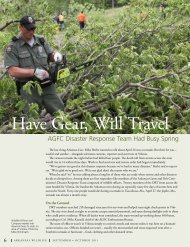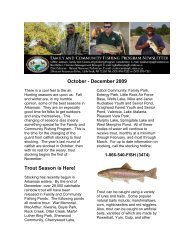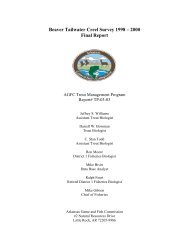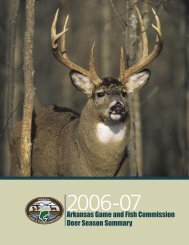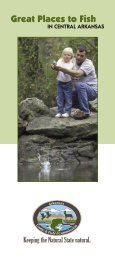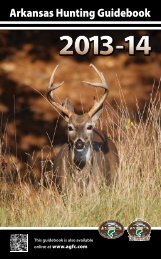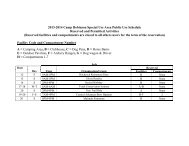Lake Conway Management Plan - Arkansas Game and Fish ...
Lake Conway Management Plan - Arkansas Game and Fish ...
Lake Conway Management Plan - Arkansas Game and Fish ...
- No tags were found...
You also want an ePaper? Increase the reach of your titles
YUMPU automatically turns print PDFs into web optimized ePapers that Google loves.
<strong>Lake</strong> <strong>Conway</strong> <strong>Management</strong> <strong>Plan</strong><strong>Arkansas</strong> <strong>Game</strong> <strong>and</strong> <strong>Fish</strong> Commission<strong>Fish</strong>eries DivisionAnd<strong>Lake</strong> <strong>Conway</strong> Citizen Advisory CommitteeOctober 2003
<strong>Lake</strong> <strong>Conway</strong> <strong>Management</strong> <strong>Plan</strong><strong>Arkansas</strong> <strong>Game</strong> <strong>and</strong> <strong>Fish</strong> Commission<strong>Fish</strong>eries DivisionAnd<strong>Lake</strong> <strong>Conway</strong> Citizen Advisory CommitteeThis program received Federal financial assistance in Sport <strong>Fish</strong> <strong>and</strong>/or Wildlife Restoration.Under Title VI of the 1964 Civil Rights Act, Section 504 of the Rehabilitation Act of 1973, Title II ofthe Americans with Disabilities Act of 1990, the Age Discrimination Act of 1975, Title IX of theEducation Amendments of 1972, the U.S. Department of the interior prohibits discrimination onthe basis of race, color, national origin, age, sex, or disability. If you believe that you have beendiscriminated against in any program, activity, or facility as described above, or if you desirefurther information please write to:The Office for Human ResourcesU.S. <strong>Fish</strong> <strong>and</strong> Wildlife Service4040 N. Fairfax DriveRoom 300Arlington, Virginia 222032
Executive Summary<strong>Lake</strong> <strong>Conway</strong> is the largest state-owned fishing lake in the state of <strong>Arkansas</strong>.Since the lake’s construction in 1948, this 6700 lake has been one of thestate’s favored fishing destinations. Due to the lake’s location just east of<strong>Conway</strong>, <strong>Arkansas</strong>, the lake’s watershed has been extensively developed <strong>and</strong>urbanized. The impacts of this urban growth have manifested themselves on<strong>Lake</strong> <strong>Conway</strong> through accelerated silt accumulation in the lake, modificationof the lake’s shoreline by adjacent l<strong>and</strong>owners, increased surface runoff ofprecipitation, <strong>and</strong> the occurrence of health notices from high levels of fecalcoliforms.The purpose of this document is to provide the <strong>Arkansas</strong> <strong>Game</strong> <strong>and</strong> <strong>Fish</strong>Commission <strong>and</strong> the public a blueprint for the management of <strong>Lake</strong> <strong>Conway</strong>that addresses the urban impacts facing the lake. The plan is a collaborativeeffort by the staff of the <strong>Fish</strong>eries Division <strong>and</strong> the private citizensparticipating on the <strong>Lake</strong> <strong>Conway</strong> Citizen Advisory Committee. The overallgoal of the plan is to provide a quality fishing lake through water levelmanipulation, vegetation control, fish stocking, <strong>and</strong> habitat enhancement.Specific objectives are: 1) balance water level manipulation for flood control<strong>and</strong> waterfowl hunting with the needs for boating access <strong>and</strong> fish production,2) reduce the conversion of natural shoreline habitat to concrete seawalls<strong>and</strong> provide information <strong>and</strong> incentives for adjacent l<strong>and</strong>owners to restoredegraded shoreline habitat, 3) reduce coverage of nuisance aquaticvegetation, primarily alligator weed, 4) maintain water quality within stateregulatory st<strong>and</strong>ards for nutrient, contaminants, <strong>and</strong> bacteria, 5) maintainlargemouth bass <strong>and</strong> crappie populations within density <strong>and</strong> size structureobjectives prescribed in their respective statewide species managementplans, 6) mark <strong>and</strong> maintain boat trails, 7) remove excessive sedimentationin selected areas to improve fish habitat <strong>and</strong> boating access, 8) reduceprivate fishing pier <strong>and</strong> boathouse structure violations, <strong>and</strong> 9) removedilapidated <strong>and</strong> unsafe fishing piers <strong>and</strong> boathouses.The plan identifies 8 action items to be undertaken upon approval of the<strong>Arkansas</strong> <strong>Game</strong> <strong>and</strong> <strong>Fish</strong> Commission over a five year period. Due to theoverall needs of <strong>Lake</strong> <strong>Conway</strong>, this plan recommends the <strong>Arkansas</strong> <strong>Game</strong><strong>and</strong> <strong>Fish</strong> Commission create a <strong>Lake</strong> Manager position to oversee this plan’simplementation as well as the day-to-day management of the lake <strong>and</strong>associated properties. Total costs for implementing this plan is estimated at$450,000 over a five year period.3
Table of Contents1. Introduction 42.0 <strong>Lake</strong> <strong>Conway</strong> Goals <strong>and</strong> Objectives 53.0 Project Description 54.0 Issue Identification 85.0 Water Level <strong>Management</strong> 86.0 Water Quality 116.1 Data Collection 116.2 Data Results 126.3 Water Quality Conclusions 147.0 Vegetation 158.0 <strong>Fish</strong> Population 169.0 Habitat Improvement <strong>and</strong> Shoreline <strong>Management</strong> 1710.0 Boat Lane Marking 1811.0 Cormorants, Turtles, <strong>and</strong> Other Bad Guys 1912.0 Sedimentation 1913.0 Access Development 2014.0 <strong>Management</strong> Action Agenda 2015.0 Evaluation 22Appendix 1. Water Level <strong>Management</strong> <strong>Plan</strong>, January 1976Appendix 2. Diet Analysis of Double-Crested Cormorants <strong>and</strong> Largemouth Bass in <strong>Lake</strong>ChicotAppendix 3. <strong>Lake</strong> <strong>Conway</strong> Flood Modeling Study – FTN Associates4
1.0 Introduction<strong>Lake</strong> <strong>Conway</strong> is the largest Commission constructed lake <strong>and</strong> the largestlake ever constructed by a state wildlife agency. Because of its large size,central location, <strong>and</strong> reputation for good fishing, it has been one of thestate’s favored fishing spots since it was built in 1948.<strong>Lake</strong> <strong>Conway</strong> was created by impounding Palarm Creek to form a 6700-acrereservoir. The Commission owns an approximate 20-foot buffer striparound the perimeter of the lake. The <strong>Lake</strong> <strong>Conway</strong> watershed containsabout 135 square miles encompassing portions of urban <strong>Conway</strong>, ruralagricultural l<strong>and</strong>s, <strong>and</strong> Camp Robinson Wildlife <strong>Management</strong> Area.Hydraulic control is maintained through a 1000 foot earthen dam with a 100foot gated spillway located at the east end of the dam. The spillway iscomprised of 16 manually operated gates. The spillway has a top crestelevation of 263.0 ft. msl <strong>and</strong> a lower crest elevation of 257 ft. msl with all16 gates open. The lake’s large watershed <strong>and</strong> low-lying lakeshoreproperties along the edge of the lake requires a concerted effort to maintain astable reservoir pool level. The pool is maintained through the opening <strong>and</strong>closing of the 16 spillway gates.Water level management has followed a prescribed operational plan since1976. Fluctuation of the pool level has long been a source of concern fromlakeshore property owners <strong>and</strong> has increased as more of the lake’s adjoiningproperties are developed for residences.This document is a blueprint for the management of <strong>Lake</strong> <strong>Conway</strong>’s waterlevel, shoreline properties, <strong>and</strong> fishery. It is the product of a collaborativeeffort between the <strong>Fish</strong>eries Division staff <strong>and</strong> the <strong>Lake</strong> <strong>Conway</strong> CitizenAdvisory Committee (LCCAC). This plan identifies nine general goals foraddressing the major issues identified by the LCCAC. Achievement of thesegoals will be sought through the implementation of eight specific actionitems recommended by the LCCAC <strong>and</strong> the <strong>Fish</strong>eries Division staff as listedin Section 14.0 of this plan. It is understood by the LCCAC thatimplementation of any item listed in Section 14.0 is subject to the approval<strong>and</strong> funding of the agency’s Commission. A five-year evaluation horizon isprescribed for the implementation of this plan.5
2.0 <strong>Lake</strong> <strong>Conway</strong> <strong>Management</strong> Goal <strong>and</strong> ObjectivesThe goal of this plan is to provide a quality fishing lake through water levelmanipulation, vegetation control, fish stocking, <strong>and</strong> habitat enhancement.Specific objectives to be accomplished by the <strong>Fish</strong>eries Division staff, inconsultation with the <strong>Lake</strong> <strong>Conway</strong> Citizen Advisory Committee, <strong>and</strong> uponapproval by the <strong>Arkansas</strong> <strong>Game</strong> <strong>and</strong> <strong>Fish</strong> Commission, are:1. Balance water level manipulation for flood control <strong>and</strong> waterfowl huntingwith the needs for boating access <strong>and</strong> fish production.2. Reduce the conversion of natural shoreline habitat to concrete seawalls<strong>and</strong> provide information <strong>and</strong> incentives for adjacent l<strong>and</strong>owners to restoredegraded shoreline habitat.3. Reduce coverage of nuisance aquatic vegetation, primarily alligatorweed.4. Maintain water quality within state regulatory st<strong>and</strong>ards for nutrient,contaminants, <strong>and</strong> bacteria.5. Maintain largemouth bass <strong>and</strong> crappie populations within density <strong>and</strong>size structure objectives prescribed in their respective statewide speciesmanagement plans.6. Mark <strong>and</strong> maintain boat trails.7. Remove excessive sedimentation in selected areas to improve fish habitat<strong>and</strong> boating access.8. Reduce private fishing pier <strong>and</strong> boathouse structure violations.9. Remove dilapidated <strong>and</strong> unsafe fishing piers <strong>and</strong> boathouses.3.0 Project Description<strong>Lake</strong> <strong>Conway</strong> is a 6700-acre Commission-owned public fishing lake located3 miles south of <strong>Conway</strong> <strong>Arkansas</strong> in Faulkner County. <strong>Lake</strong> <strong>Conway</strong> is thelargest lake ever created by a state conservation agency. Recreational6
Figure 1. Topographic map of <strong>Lake</strong> <strong>Conway</strong>.7
fishing <strong>and</strong> waterfowl hunting are the expressed purposes of the lake. Thelake was constructed in 1948 by impounding Palarm Creek. Public access isprovided through five public boat ramps (Figure 1) <strong>and</strong> two fishing piers.Several private commercial boat docks provide boating access for a modestfee. The Commission maintains a 20 foot buffer strip along the perimeter ofthe lake.<strong>Lake</strong> <strong>Conway</strong> watershed is a fan shaped area comprising about 135 squaremiles. Major tributaries are Palarm Creek, Caney Creek, Pierce Creek, GoldCreek, <strong>and</strong> Stone Dam Creek. The lake’s watershed contains both highlydeveloped urban <strong>and</strong> rural agricultural areas. A portion of the city of<strong>Conway</strong>’s wastewater treatment discharge enters the lake from Stone DamCreek.<strong>Lake</strong> <strong>Conway</strong> Dam <strong>and</strong> Spillway is anearthen fill structure about 1000 feetlong with a spillway on the east end.The spillway has a crest length ofabout 100 feet. The spillway containssixteen 6 foot by 6 foot vertical gatesthat are operated to manipulate thewater level <strong>and</strong> release floodwaters.One gates is dedicated to the filling ofthe Bell Slough Waterfowl Area with <strong>Lake</strong> <strong>Conway</strong> Water Level Control Structurewater for duck hunting. All gates areelectrically operated by screw st<strong>and</strong>s. The earthen dam contains two 24-inchsluice gates that are rarely opened. Normal pool level on the lake is 263.0 ft.msl.The lake’s water level control plan (Appendix 1) was implemented in themid-1970s following the recommendations of a consulting engineer (Z<strong>and</strong>erReport, 1975). The plan calls for a winter draw down of one foot (262.0 ftmsl) for flood storage <strong>and</strong> proscribes opening of spillway gates in a stepwisefashion based on the lake’s water level to prevent inundation of the Grassy<strong>Lake</strong> Road Bridge located approximately ½ mile downstream of the dam.The lake contains a warm water fishery comprised primarily of largemouthbass, black <strong>and</strong> white crappie, bluegill, redear, channel catfish, <strong>and</strong> flatheadcatfish. Gizzard shad is a principle prey species for predators. The lake hasa historical reputation for quality bluegill <strong>and</strong> redear.8
The lake is sampled annually using a combination of electrofishing, coverotenone,shoreline seining, <strong>and</strong> trap netting. Largemouth bass <strong>and</strong> crappieare managed to achieve population density <strong>and</strong> size-structure objectivesdescribed in these respective species plans. Statewide harvest regulationsapply on all sport species with no special harvest restrictions. Additionalfish management activities include routine stocking through a 20-acrenursery pond. A polyculture of crappie <strong>and</strong> channel catfish is the st<strong>and</strong>ardnursery pond crop, with periodic crops of yearling largemouth bass.4.0 Issue IdentificationWater level fluctuation has been problematic on <strong>Lake</strong> <strong>Conway</strong> throughoutthe lake’s existence. The continual growth of full time residences along thelake’s shore plus the gradual filling in of the lake basin throughsedimentation has resulted in an increasing number of public complaints onthe lake’s water level operation during the winter lower pool operation.Citizens have been concerned over possible contamination from thewastewater treatment facility effluent <strong>and</strong> poorly designed <strong>and</strong> constructedseptic systems.In July 2001, the Commission directed the <strong>Fish</strong>eries Division to convene apanel of citizens to assist the staff in drafting a new lake management plan.An Issue Identification Hearing was conducted in <strong>Conway</strong> on September 11,2001 to allow the public to express their concerns <strong>and</strong> identify lake problemsto be addressed in a management plan. Table 1 is a list of issues identifiedby the public to be addressed on <strong>Lake</strong> <strong>Conway</strong>. An open advisory panel,designated the <strong>Lake</strong> <strong>Conway</strong> Citizen Advisory Panel (LCCA), was formedof volunteers. Table 2 is a list of regularly attending panel members. TheLCCA met monthly, beginning in November 2001, to discuss problemissues <strong>and</strong> hear presentations by staff <strong>and</strong> outside professionals.5.0 Water level <strong>Management</strong>The study by FTN 2002 confirmed the earlier Z<strong>and</strong>er report1975 concludingthat the lake being 1.0 ft. low is important in controlling flood events bothup stream <strong>and</strong> down from the dam. Options discussed included exp<strong>and</strong>ingthe size of the spillway <strong>and</strong> elevating the Grassy <strong>Lake</strong> Road <strong>and</strong> Bridge.Flood analysis by the <strong>Arkansas</strong> Highway <strong>and</strong> Transportation Department9
Table 1. <strong>Lake</strong> <strong>Conway</strong> Advisory CommitteeIssues/Problems for Resolution1. Water level management 7. Cormorants2. <strong>Fish</strong> population 8. Turtles3. Vegetation 9. Shoreline Development4. Water Quality 10. Access Development5. Sedimentation6. Boat TrailsTable 2. <strong>Lake</strong> <strong>Conway</strong> Citizen Advisory Committee Members.NameHome CityGilbert Baker <strong>Conway</strong>Jason Banks <strong>Conway</strong>Richard H. Bates MayflowerBill Beall SherwoodSmitty Burgess MayflowerJim Butler MayflowerJudi Cardin <strong>Conway</strong>Len Carter <strong>Conway</strong>Cary DeBoard <strong>Conway</strong>Murray Draper SherwoodWilliam Duvall Sr. MayflowerBr<strong>and</strong>y & Gay <strong>Conway</strong>Ralph Gilkerson JacksonvilleJohn Gueringer <strong>Conway</strong>Robert Halter <strong>Conway</strong>Ed Hankins MayflowerJ.D. Hausler MayflowerRoss Higgins Little RockJack Johnson <strong>Conway</strong>Bennie F. Jones SherwoodLewis Jones <strong>Conway</strong>Larry Keathley <strong>Conway</strong>Jon Lauritzson <strong>Conway</strong>Bob Lowrey MayflowerJudy Manley Mayflower10
Ken Olver MayflowerJames Oliver MayflowerAlan Ott <strong>Conway</strong>Gene & Owens JacksonvilleFranklin Pearce MayflowerBill Ramsey Little RockBill Ramsey, Jr. <strong>Conway</strong>Carl Riley <strong>Conway</strong>Arthur Royston MayflowerPreston Scroggins ViloniaCarroll D. Smith <strong>Conway</strong>Christopher Spencer <strong>Conway</strong>Mack Snyder <strong>Conway</strong>Bill Stovall <strong>Conway</strong>Jerry Surratt <strong>Conway</strong>Monty Vickers MayflowerLloyd Wilcox MayflowerGreg Woodard <strong>Conway</strong>John Woodard North Little RockRay York Mayflower(AHTD) indicated a minimum elevation of six feet is needed to raise theroadway above the 100-year flood plain, but significant relief would berealized through elevating the road <strong>and</strong> bridge three feet. Since Grassy <strong>Lake</strong>Road currently passes under Interstate 40, the preferred route includedlinking Grassy <strong>Lake</strong> Road with an existing county road on the north side ofI-40 (Figure 1). The AGFC negotiated a project to elevate the bridge <strong>and</strong>road approach with officials from Faulkner County, Army National Guard,AHTD, <strong>and</strong> the residents of Rogers Subdivision. AGFC committed$100,000 cash <strong>and</strong> fill material towards elevating the road <strong>and</strong> bridge aminimum of three feet. This is considered the first phase of theimprovements. Phase II will attempt to link the Grassy <strong>Lake</strong> Road to anexisting roadway north of I-40 <strong>and</strong> eliminate the need to pass under theinterstate.The current water level operation plan calls for the lake to be at 262 feetmean sea level (msl) November 15 th to April 15 th <strong>and</strong> at 263 ft. msl fromApril 15 th to November 15 th . This plan tries to balance flood risk above <strong>and</strong>below the dam <strong>and</strong> give as much flood control as practical while providingnormal lake levels for the spawn. Due to the fact that winters have been11
milder in recent years, the raising of the level back to 263msl may need to beat an earlier date than April 15 th. A solution to this problem is to bring thelake back to 263msl March 15 th instead of April 15 th . This change inoperation would increase the flooding risk from March 15 th to April 15 th .Lowering the lake during the winter to 262 feet msl will be ended when <strong>and</strong>if the Grassy <strong>Lake</strong> Road <strong>and</strong> Bridge are raised above the 100-year floodplain. Raising the road <strong>and</strong> bridge three feet will provide significantimprovement <strong>and</strong> the opportunity to hold <strong>Lake</strong> <strong>Conway</strong> at 263.0 feet mslyear-round. Once Grassy <strong>Lake</strong> Road is elevated, the water levelmanagement plan will be modified towards holding the lake at 263.0 ft mslyear-round on a trial basis.Releases for Bell Slough Green Tree Reservoir (GTR) are currentlyunrestricted. While these releases in the late summer <strong>and</strong> early fall are notharmful to the lake’s fishery, these releases can exacerbate already lowwater levels <strong>and</strong> hamper boating access. The LCCAC recommends thatreleases into the GTR be restricted to pool elevations above 262.0 ft. msl.Two sluice gates through the dam allow the complete draining of <strong>Lake</strong><strong>Conway</strong>. These pipes leak <strong>and</strong> are to be repaired as soon as possible. Ifthese pipes do not leak the lake will hold up better through the summer.6.0 Water QualityIn July 1998, concerned citizens residing in the area around <strong>Lake</strong> <strong>Conway</strong>requested that the <strong>Arkansas</strong> Department of Pollution Control <strong>and</strong> Ecology(Department) conduct a study to determine the extent of possiblecontamination in <strong>Lake</strong> <strong>Conway</strong>. The citizens were concerned that theeffluent discharge from waste water treatment facilities (WWTF) <strong>and</strong> poorlymaintained <strong>and</strong> operated septic systems may be causing unacceptable levelsof nutrients, metals, <strong>and</strong> fecal coliform bacteria in the lake. Additional waterquality concerns expressed to the <strong>Arkansas</strong> Commission on PollutionControl <strong>and</strong> Ecology prompted additional data collection in March, April,<strong>and</strong> August 2001.6.1 Data CollectionThe data included in this report has been compiled from four samplingevents:12
October 12, 1998 - Water quality, dissolved metals, <strong>and</strong> fecal coliformbacteria were collected from five stations on <strong>Lake</strong> <strong>Conway</strong> (Figure 1). Datafrom this sampling event is shown in Table 1. It should be noted that thewater level in <strong>Lake</strong> <strong>Conway</strong> was very low during this sampling event due toa designed draw down of the lake by AGFC, <strong>and</strong> the water temperature wasbelow 70 o F.Location of Sample StationsHwy 89 - Hwy 89 at the first bridge after exiting I-40.Narrows - Hwy 89 at the narrows bridge.Gold Creek -At the first bridge on I-40 (Gold Creek) betweenthe cities of Mayflower <strong>and</strong> <strong>Conway</strong>.Stone Dam Cr - At the second bridge on I-40 (Stone DamCreek) between the cities of Mayflower <strong>and</strong> <strong>Conway</strong>.Caney Creek - At the <strong>Arkansas</strong> <strong>Game</strong> <strong>and</strong> <strong>Fish</strong> Caney Creekaccess to <strong>Lake</strong> <strong>Conway</strong> on Amity Road in <strong>Conway</strong>.July 1999 - Water quality, dissolved metals, <strong>and</strong> fecal coliform bacteriacollected from transects across the upper <strong>and</strong> lower ends of <strong>Lake</strong> <strong>Conway</strong>during the project titled “Water Quality Assessment of <strong>Arkansas</strong>’ SignificantPublicly-Owned <strong>Lake</strong>s.”March 27, 2001(Table 2) - Water quality <strong>and</strong> dissolved metals collectedfrom the same five stations identified during the October 12, 1998 event.April 10, 2001 - Fecal Coliform bacteria samples were collected by boat at50 locations in <strong>Lake</strong> <strong>Conway</strong>. Samples were evenly distributed around thelake <strong>and</strong> were collected near the shoreline. Data from this sampling event isshown in Table 3.6.2 Data ResultsThe most elevated concentration of total phosphorus in <strong>Lake</strong> <strong>Conway</strong> was1.86 mg/L at the Stone Dam Creek station in August 2001 (Figure 2). Thishas increased from 1.14 mg/L in March 2001 <strong>and</strong> 0.86 mg/L in October1998. The Stone Dam Creek site has consistently produced the mostelevated total phosphorus concentrations since 1998. All other stationsindicated concentrations of total phosphorus at or below 0.17 mg/L, with theexception of 0.45 mg/L collected in August 2001 at the Palarm Creekstation.13
Nitrate-nitrogen concentrations were most elevated at the Stone Dam Creeksite. In 1998, water samples indicated a concentration of 4.17 mg/L nitrates.In March 2001, a concentration of 7.43 mg/L was collected at the samelocation. In August 2001, a concentration of 1.25 mg/L was recorded atStone Dam Creek. All other stations indicated nitrate concentrations at orbelow 0.50 mg/L (Figure 3).Chloride concentrations were relatively low at all stations with theexception of Stone Dam Creek. This station indicated chlorideconcentrations of 45.5 mg/L <strong>and</strong> 44.0 mg/L for 1999 <strong>and</strong> March 2001,respectively. The August 2001 sampling event indicated a chlorideconcentration of 46.6 mg/L. All other stations produced chlorideconcentrations at or below 10.9 mg/L (Figure 4).Fecal Coliform bacteria samples collected during the October 1998 eventat the five tributary stations produced concentrations of 590 col/100ml <strong>and</strong>560 col/100ml at Gold Creek <strong>and</strong> Stone Dam Creek, respectively. At thesame stations in March 2001, the concentrations were much reduced, withconcentrations of ~10 <strong>and</strong> ~20 col/100ml. In August 2001, the mostelevated concentration of fecal coliform bacteria collected at these same fivestations was 320 col/100ml <strong>and</strong> 252 col/100ml at Hwy 89 <strong>and</strong> Caney Creek,respectively (Figure 5).Concentrations of Fecal Coliform bacteria were very low at all 50 shorelinestations collected during the April 2001 event (Figure 6). Eighty-fivepercent of water samples collected around the shore of <strong>Lake</strong> <strong>Conway</strong>produced concentrations of 10-col/100 ml or less. The western shore of the<strong>Lake</strong> produced the majority of bacterial counts above 10 col/100ml;however, no concentrations were found to exceed 30 col/100ml in the April2001 collections.Concentrations of Fecal Coliform bacteria around the <strong>Lake</strong> <strong>Conway</strong>shoreline were also low in August 2001 (Figure 7). Excluding the fivetributary stations previously discussed, only five stations indicated fecalcoliform counts over 100 col/100ml <strong>and</strong> these exhibited near r<strong>and</strong>omdistribution around the lake. The most elevated concentration of fecalcoliform bacteria collected from the 50 lake stations was 300 col/100mlfrom a location near the Palarm Creek L<strong>and</strong>ing.14
Dissolved copper was detectedat higher concentrations onMarch 27, 2001 than on previoussampling events (Figure 8). Themost elevated concentration of3.65 µg/L was indicated at theStone Dam Creek station. In1998 <strong>and</strong> in August 2001, onlythe sample collected at the StoneDam Creek station produced aconcentration of copper abovethe ADEQ laboratory detectionlimit, this value was below toxic levels.Dissolved lead was also found in the highest concentration of 0.58 µg/L atthe Stone Dam Creek station in March 2001, <strong>and</strong> the Caney Creek samplerevealed a lead concentration of 0.46 µg/L (Figure 9). In October 1998 <strong>and</strong>August 2001, no samples indicated lead levels above the ADEQ laboratorydetection limit.Using the ecoregion hardness value for calculating toxic levels as prescribedin the implementation procedure, none of the dissolved metals were found tobe acutely toxic. However, the concentrations of copper (3.65 µg/L) <strong>and</strong>lead (0.58 µg/L) collected on March 27, 2001 slightly exceed the chronictoxicity values for copper <strong>and</strong> lead of 3.5 µg/L <strong>and</strong> 0.5 µg/L, respectively.6.3 Water Quality Conclusions<strong>Lake</strong> <strong>Conway</strong> has good water quality that meets or exceeds state waterquality st<strong>and</strong>ards. The results of these data collection activities demonstratethe influence of a municipal WWTF on a tributary entering <strong>Lake</strong> <strong>Conway</strong>.Several parameters, including nutrients, chlorides <strong>and</strong> some heavy metalswere noticeably elevated below the city of <strong>Conway</strong> WWTF although thevalues are typical of most municipal WWTF discharges.Little can be concluded from the fecal coliform bacteria data, except, underthe conditions that existed at the time of the collection, none of the valueswere considered to be excessive.15
Contaminant levels in edible portions of largemouth bass <strong>and</strong> channel catfishwere well below Food <strong>and</strong> Drug Administration action levels <strong>and</strong> no healthadvisories or warnings exist for <strong>Lake</strong> <strong>Conway</strong>. The general public shouldhave no fear of consuming fish taken from <strong>Lake</strong> <strong>Conway</strong>.7.0 Vegetation<strong>Lake</strong> <strong>Conway</strong> is presently about 22% covered with various species ofvegetation, primarily lily pad. The recommended coverage for all vegetationtypes to benefit largemouth bass is 20-35%. Figure 2 shows areas withextensive vegetative covering.Figure 2. <strong>Lake</strong> <strong>Conway</strong> Aquatic Vegetation Coverage as of Summer 2002.Vegetation management on <strong>Lake</strong> <strong>Conway</strong> will employ four strategies: 1)aggressive eradication of alligator weed, 2) open boat trails to improveangler access, 3) allow adjacent private l<strong>and</strong>owners to use herbicides to treatshoreline areas under permit, <strong>and</strong> 4) waterlevel drawdowns as a systemiccontrol when local <strong>and</strong> strategic control is not sufficient.]16
AGFC personnel will control alligator weed with permitted herbicides eitherusing in-house labor or by contract. Boat lanes selected for herbicidetreatment will be decided annually in consultation with the <strong>Lake</strong> <strong>Conway</strong>Advisory Committee.8.0 <strong>Fish</strong> PopulationThe fish population samples at <strong>Lake</strong> <strong>Conway</strong> indicate a relatively goodpopulation. The total biomass<strong>Lake</strong> <strong>Conway</strong> <strong>Fish</strong> Biomass (kg/ha) from cove-rotenone samples over a30 year period.3503002502001501005001972197519791982198519881991199419972000Largmouth BassBluegillCrappieRedearTotal X 10has fluctuated around 500kg/ha for most of the last 30years. This indicates arelatively fertile lake.Largemouth bass at 40 kg/ha<strong>and</strong> bream at over 100 kg/hais better than in most lakes inthe area. Largemouth basssize structure <strong>and</strong> density hasconsistently met or exceededmanagement plan objectives(Figure 3). Sampling in 2001 revealed a crappie assessment value of 95, ashigh as any in the state.17
90807060504030201001996 1997 1998 1999 2000CPUEPSD % 12"largerRSD % 15"largerFigure 3. Largemouth bass population trends in <strong>Lake</strong> <strong>Conway</strong>, 1996 –2000. Catchper unit effort (CPUE) reported in fish per electro-fishing hour.Stocking is done on a regular basis from the <strong>Lake</strong> <strong>Conway</strong> Nursery Pond.Catfish, crappie <strong>and</strong> largemouth bass have been stocked from the nurserypond in the past. In the past, 3 to 4 years were devoted to crappie <strong>and</strong> catfishto one for largemouth bass, which seems to work well. The 2003 crop willbe largemouth bass with the 2004 <strong>and</strong> 2005 crops being crappie <strong>and</strong> catfish.9.0 Habitat Improvements <strong>and</strong> Shoreline <strong>Management</strong>L<strong>and</strong>owners can improve the fish habitat within the lake <strong>and</strong> along theirshoreline. The construction of bream spawning areas by placing gravel inthe area around their property should help spawning. <strong>Plan</strong>s can be obtainedfrom the <strong>Arkansas</strong> <strong>Game</strong> <strong>and</strong> <strong>Fish</strong> Commission. The construction of brushshelters using trees, large branches, <strong>and</strong> Christmas trees will be helpful inconcentrating fish for harvest. These structures should be constructedoutside of boat lanes. At the present time there seems to be sufficientcomplex structure in <strong>Lake</strong> <strong>Conway</strong> for the fish population. Additional brushpiles or similar structure will not have a good cost benefit ratio. Asdiscussed elsewhere in this plan, <strong>Lake</strong> <strong>Conway</strong> does lack suitable substratefor shallow, nest-spawning fish such as bluegill. Much of the shoreline has18
suffered from siltation. Gravel spawning beds are a good alternative habitatenhancement for <strong>Lake</strong> <strong>Conway</strong>.The shoreline of <strong>Lake</strong> <strong>Conway</strong> has been extensively modified for shorelinestabilization using concrete seawalls <strong>and</strong> riprap. This practice, whilecurrently allowed by the Commission, has led to the loss of valuable shallowwater habitat. Shoreline habitat is needed for spawning <strong>and</strong> nursery areas.The current L<strong>and</strong> Use Policy Around <strong>Arkansas</strong> <strong>Game</strong> <strong>and</strong> <strong>Fish</strong> Commission<strong>Lake</strong>s is under review <strong>and</strong> changes to shoreline stabilization allowances arebeing considered. We recommend ending the practice of allowing concreteseawalls on <strong>Lake</strong> <strong>Conway</strong> <strong>and</strong> the development of a Shoreline <strong>Management</strong>Manual for <strong>Lake</strong> <strong>Conway</strong> that offers alternatives for stabilizing a sloughingbank while providing quality shoreline habitat.The AGFC has historically maintained a very liberal policy on theconstruction of fishing piers <strong>and</strong> boathouses by adjacent l<strong>and</strong>owners. Whilethis policy has benefited a large number of anglers accessing <strong>Lake</strong> <strong>Conway</strong>,aging structures <strong>and</strong> poor maintenance practices by l<strong>and</strong>owners has resultedin a large number of dilapidated structures that detract from the aestheticquality of the lake. These structures are unsafe eyesores. We recommendthe 1) aggressive enforcement of existing boathouse permitting regulations,2) implementing a program to destroy any structure not meeting minimumstructure st<strong>and</strong>ards, <strong>and</strong> 3) efforts to educate <strong>and</strong> inform the public on AGFCL<strong>and</strong> Use Policy be increased.10.0 Boat Lane Marking<strong>Lake</strong> <strong>Conway</strong> is a relatively shallow, stump-filled lake. Most of the stumpshave rotted to the waterline, creating a boating hazard. Boat lanes werecreated during lake construction to facilitate boating access throughout thelake. The public marked these boat lanes in recent years with the AGFCfurnishing materials. The <strong>Lake</strong> <strong>Conway</strong> Bass Club did a large percentage butnot all of this work. Boat lane marking has to be done by someone who isintimately familiar with the trails <strong>and</strong> in a manner that is not confusing tonew users of the lake. These conditions can prove to be a challenge.We recommend that all the primary designated boat trails be marked at thistime using st<strong>and</strong>ard navigation markers (Figure 1). The <strong>Arkansas</strong> <strong>Game</strong> <strong>and</strong><strong>Fish</strong> Commission will purchase the materials <strong>and</strong> either recruit volunteers to19
mark the trails with the oversight of the District <strong>Fish</strong>eries Biologist or outsourcethe work to a private contractor.11.0 Cormorants, Turtles, <strong>and</strong> Other Bad GuysDouble-crested Cormorants (DCC)numbers have increased rapidly ineastern <strong>Arkansas</strong> since the 1970's. Thisincrease has led to conflicts with theeconomically valuable aquacultureindustry, <strong>and</strong> more recently, the birdshave been implicated in damagingrecreational sport fisheries. DoublecrestedCormorants were identified in the<strong>Lake</strong> <strong>Conway</strong> issue identificationmeeting as a major concern amonganglers. Double-crested Cormorant dietshave been studied extensively in the United States, including a recent studycompleted by the Aquatic Research Center in Stuttgart, AR on cormorantsresiding at <strong>Lake</strong> Chicot. The summary results of this study, combined withthe results of the largemouth bass food habits study contracted by the AGFCthrough the University of <strong>Arkansas</strong> at Pine Bluff are presented in Appendix2. This study concludes there is no evidence that DCC or largemouth bassare a significant contributor to poor crappie recruitment in <strong>Lake</strong> Chicot.Double-crested Cormorants remain a source of concern to the <strong>Arkansas</strong><strong>Game</strong> <strong>and</strong> <strong>Fish</strong> Commission largely through their known impact to theaquaculture industry <strong>and</strong> their potential to impact sport fisheries under theright situations (New York Department of Environmental Conservation1999). The U.S. <strong>Fish</strong> <strong>and</strong> Wildlife Service has published a DraftEnvironmental Impact Statement on the management of DCC. The AGFCsupports the establishment of regional population levels for DCC to reducedamage on aquaculture facility <strong>and</strong> the potential to harm sport fisherieswhile maintaining a self-sustaining population of the birds.12.0 SedimentationSilt accumulation is a major problem with no easy solution. Siteinvestigations show that the silt on the bottom of <strong>Lake</strong> <strong>Conway</strong> averages 1820
inches <strong>and</strong> may be as deep as 5 feet in some areas. <strong>Lake</strong> <strong>Conway</strong> averaged 6feet when the gates were closed therefore the volume has been reduced 25%.Removal of silt is expensive. It can be pumped short distances onto dry l<strong>and</strong>or the lake can be dried out <strong>and</strong> the silt removed by heavy equipment. At thistime the <strong>Lake</strong> <strong>Conway</strong> Improvement Committee is not in favor of a largescalesilt removal project. The time the lake would have to be down is toohigh a cost for the benefits obtained. Small scale dredging projects byl<strong>and</strong>owners will be allowed by permit in conjunction with shorelineimprovement work. The AGFC <strong>and</strong> LCCAC will investigate the feasibilityof dredging selected coves during a draw down to improve fish habitat <strong>and</strong>boating access.13.0 Access Development<strong>Lake</strong> <strong>Conway</strong> is accessed by five hard-surface public launch sites <strong>and</strong> twopublic fishing piers (Figure 1). The lake is also serviced by threecommercial boat docks that provide launching facilities for a fee. A twentyfootbuffer strip surrounds the lake providing foot traffic access to theshoreline. No additional access sites are anticipated.14.0 <strong>Management</strong> Action AgendaThe <strong>Lake</strong> <strong>Conway</strong> Citizen Advisory Committee <strong>and</strong> the <strong>Arkansas</strong> <strong>Game</strong> <strong>and</strong><strong>Fish</strong> <strong>Fish</strong>eries Division agree to pursue the following management actionitems for <strong>Lake</strong> <strong>Conway</strong>. It is further understood that any recommendedaction item may require funding <strong>and</strong> staffing approval from the agency’sCommission <strong>and</strong> the items inclusion in this list does not ensure thatapproval.1. The water level management plan will be modified as improvements aremade to the Grassy <strong>Lake</strong> Road <strong>and</strong> bridge that allow for larger releases ofwater from <strong>Lake</strong> <strong>Conway</strong>. The goal is to eventually keep a full pool (263.0ft. msl) year-round. The current recommended plan is as follows:Normal pool level for <strong>Lake</strong> <strong>Conway</strong> is 263.0 ft. msl.During the period from 15 March to 15 November, no morethan three gates will be opened on pool rises until the lake levelreaches 264.3 ft. msl, after which sufficient gates will beopened to prevent further rise of the pool <strong>and</strong> bring the poolback to normal level.21
The pool will be lowered one foot to a level of 262.0 ft. mslfrom 15 November to 15 March to accommodate heavierseasonal precipitation. During this period no more than threegates will be opened on pool rises until the pool reaches 263.3msl, after which sufficient gates will be opened t prevent furtherrise of the pool elevation <strong>and</strong> return to pool level to 262.0 ft.msl.Pool levels above 262.0 ft. msl. may be used to flood the BellSlough WMA from 1 October through 15 March.No increased maintenance <strong>and</strong> operation costs are anticipated with this item.2. The AGFC will meet annually with the LCCAC to review water levelmanagement operations <strong>and</strong> adjust as circumstances allow. For example,completion of the first phase of the Grassy <strong>Lake</strong> bridge construction mayprovide opportunity for higher releases from the lake without a safety riskfrom flooding the road <strong>and</strong> bridge.No increased maintenance <strong>and</strong> operation costs are anticipated with this item.3. The AGFC will treat nuisance aquatic vegetation, primarily alligatorweed <strong>and</strong> yellow water lily in areas where the vegetation is preventingaccess to fishing areas. Annual estimated cost is $15,000.00.4. The AGFC will allow riparian l<strong>and</strong>owners to spot treat nuisance aquaticvegetation around their piers <strong>and</strong> boathouses under a permit. No increasedcosts are anticipated with this item.5. AGFC will investigate <strong>and</strong> develop an engineering feasibility plan withassociated cost estimates to dredge selected areas of the lake to improvefishery habitat <strong>and</strong> boating access. An estimated cost to this item will bedeveloped as part of the feasibility analysis, but a comparable project on<strong>Lake</strong> Bois’d Arc cost $150,000.00.6. AGFC will develop <strong>and</strong> distribute to adjoining l<strong>and</strong>owners a l<strong>and</strong>owner’sguide to managing lake shorelines for wildlife <strong>and</strong> fishery habitat.Estimated cost is $25,000.00.7. AGFC will identify privately constructed fishing piers <strong>and</strong> boathousesthat are out of compliance with the Commission’s L<strong>and</strong> Use Policy Around22
Commission-owned <strong>Lake</strong>s. Staff will work with pier <strong>and</strong> boathouse ownersto either bring the structure into compliance or remove the offendingstructure. Estimated cost for removing derelict structures is $10,000.00.8. AGFC will assign a <strong>Lake</strong> Manager position to oversee the managementof the lake’s water level <strong>and</strong> the implementation of this plan. The lakemanager will mark <strong>and</strong> maintain boatlanes, inspect fishing piers <strong>and</strong> boathouses for compliance, assist the District Biologist on fish populationsamples, <strong>and</strong> provide programs to area groups about <strong>Lake</strong> <strong>Conway</strong>. Annualestimated cost for employing <strong>and</strong> outfitting a Biologist I position is$50,000.00Total cost for implementing the recommendations contained in this plan areestimated at $450,000.00 over the five year implementation period.15.0 EvaluationThe goals <strong>and</strong> <strong>Management</strong> Action Agenda identified in this plan will beevaluated on a five-year cycle to determine if the stated goals are beingaccomplished. The AGFC staff will monitor trends in the fishery throughannual fish population sampling. AGFC staff will meet with the LCCAC atleast once annually to review sampling results <strong>and</strong> management activities.The annual meetings will allow minor adjustments to the plan as opportunity<strong>and</strong> need arise.23
Appendix 124
Appendix 2Diet Analyses of Double-Crested Cormorants <strong>and</strong> Largemouth Bass in <strong>Lake</strong> ChicotAmy S. Fenech*, Graduate Research AssistantDr. Steve Lochmann, Assistant ProfessorDr. Andrew A. Radomski, Research Wildlife BiologistThis study involves examining the diet of double-crested cormorants <strong>and</strong>largemouth bass feeding at <strong>Lake</strong> Chicot, a 10-mile long public oxbow located insoutheastern <strong>Arkansas</strong>. The project was initiated after public concerns regarding thesport fishery of <strong>Lake</strong> Chicot. The hypothesis is to test if these piscivorous predators arenegatively affecting the sport fish populations in <strong>Lake</strong> Chicot. In addition, we have usedelectroshocking <strong>and</strong> rotenone data to determine fish diversity <strong>and</strong> abundance <strong>and</strong> havedetermined cormorant numbers in the vicinity using aerial survey data.We have completed one year of cormorant <strong>and</strong> largemouth bass collections.Cormorants were collected at <strong>Lake</strong> Chicot from the time of their late arrival in January2001 until their departure in April 2001. Cormorant collections resumed in early October2001 when they returned <strong>and</strong> ended in late December 2001 after we achieved our samplesize. Approximately 450 cormorants were killed to comprehensively examine stomachcontents. Whole prey fish <strong>and</strong> digested remains were examined. Hard remains(specifically otoliths) allowed us to quantify <strong>and</strong> identify prey species <strong>and</strong> to estimateprey size at time of consumption. Largemouth bass were collected in November 2000,<strong>and</strong> in February, March, May, <strong>and</strong> August 2001. Approximately 300 bass were collected.Stomach contents were removed using a non-lethal method <strong>and</strong> all bass were releasedback into the lake.These data are used to address the following concerns relative to the issue ofcormorants:1. The proportion of commercially <strong>and</strong> recreationally important fish speciespresent in the diet of cormorants <strong>and</strong> the relative importance <strong>and</strong> selectivity ofcormorants for those species.2. Competition for forage fish between cormorants <strong>and</strong> largemouth bass.The diet of cormorants collected at <strong>Lake</strong> Chicot is comprised mostly of gizzardshad (Dorosoma cepedianum) <strong>and</strong> yellow bass (Morone mississippiensis). These twoprey fish make up 63% <strong>and</strong> 19% of cormorant diet, respectively. The diet of cormorantsalso included 5% channel catfish (Ictalurus punctatus), 5% sunfish (Lepomis spp.), <strong>and</strong>7% minnows (Cyprinidae). Other fish species found less frequently in the diet ofcormorants included a few freshwater drum (Aplodinotus grunniens) <strong>and</strong> silversides(Atherinidae), one white bass (Morone chrysops), two largemouth bass (Micropterussalmoides) <strong>and</strong> one white crappie (Pomoxis annularis). Although these proportionsvaried seasonally, gizzard shad <strong>and</strong> yellow bass remained the most common prey speciesfound in the diet.Stomach content data <strong>and</strong> relative abundance data for fish in <strong>Lake</strong> Chicot wereused to calculate an index representing cormorant selectivity. Cormorants appear to beselecting gizzard shad <strong>and</strong> yellow bass. This means that cormorants are consuming these25
two species in a higher proportion than they are found in the environment. A relativeimportance index for cormorant prey species was also calculated. The importance ofgizzard shad <strong>and</strong> yellow bass exceeds that of all other prey species.A diet overlap index was used to determine whether cormorants <strong>and</strong> largemouthbass were competing for the same species of prey. The calculated diet overlap was 25%,which means that although cormorants <strong>and</strong> largemouth bass prey upon some of the samespecies, diet overlap is not biologically important (greater than 60%). Even thoughcormorants <strong>and</strong> largemouth bass consume common prey species, it appears that they arenot in competition for the same size prey. Largemouth bass consume smaller fish (meanprey st<strong>and</strong>ard length = 77 mm) <strong>and</strong> cormorants consume larger fish (mean prey st<strong>and</strong>ardlength = 163 mm).Overlap in cormorant <strong>and</strong> largemouth bass diets were minimal. Cormorants wereselecting gizzard shad <strong>and</strong> yellow bass. Cormorants have the potential to eat sport fishwhen other species important in their diet are not available. Based on our findings,cormorants are not having a negative impact on the sport fishery in <strong>Lake</strong> Chicot.Amy S. FenechGraduate Research AssistantUniversity of <strong>Arkansas</strong> at Pine BluffDepartment of Aquaculture <strong>and</strong> <strong>Fish</strong>eriesMail Slot 4912Pine Bluff, AR 71611(870) 543-8107afenech@uaex.edu26




